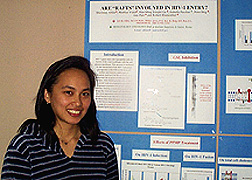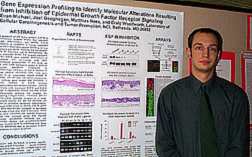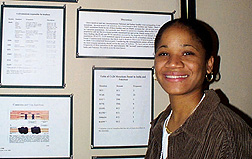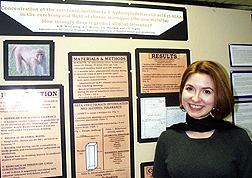
| T H E N I H C A T A L Y S T | M A Y - J U N E 2000 |
|
|
|
POSTBACCALAUREATE POSTERS:REFLECTIONS OF RESEARCH FUTURES |
text and photos
|
April 1994 marked the beginning of the NIH Postbaccalaureate Program. March 2000 marked the beginning of what will be an annual postbac poster session.
Among the youngest of the pre-IRTAs on campus, postbacs are recent college graduates who are considering research careers and whose year or two in an NIH lab is meant to fan the flames of their interest in biomedical research. Ideally, postbacs apply to graduate or medical schools while working in the NIH program.
Sponsored by the Office of Education, the postbac poster session was held in the Clinical Center in conjunction with a Wednesday Afternoon Lecture and showcased the research of about 75 trainees. What follows is a random sample of the presenters and their work. Common themes, on a personal level, were unbridled praise for mentors and the NIH research experience and their pursuit of careers in clinical medicine and research—with a smattering of laments over having to study for the MCAT.
Sherimay
Ablan
"Are
rafts involved in HIV-1 entry?"
 |
|
Sherimay Ablan
is applying to medical school and describes her lab as "diverse and
intellectually stimulating."
|
Sherimay Ablan’s research findings suggest that glycosphingolipids may be involved in the assembly and function of the HIV-1 fusion machine. HIV-1 gains entry into cells via interactions between its envelope glycoproteins, gp120 and gp41, and the CD4 receptor (and other co-receptors) on the host cell membrane. Subsequently, viral glycoprotein oligomers assemble to form molecular scaffolds that serve to precipitate the fusion event between viral and host membranes. The researchers found that by inhibiting the synthesis of glycosphingo-lipids in the host cells, they could affect the HIV-1 fusion event and infection. This function could be recovered, however, by the subsequent addition of purified glycosphingolipids to the impaired cells. Additionally, glycosphingolipid-cholesterol-rich domains form phase-separated membrane "rafts" that are suspect sites for viral entry. When human osteosarcoma cells were depleted of cholesterol, they were significantly less susceptible to glycoprotein-mediated fusion.
Ablan graduated in the spring of 1999 from the University of Hawaii at Manoa and confided that this was her "first time living away from home." She was encouraged to apply to the pre-IRTA program by a good friend (an alumnus of the pre-IRTA fellowship), as well as by Deborah Cohen, the coordinator of NIH postdoctoral training programs, whom she met while presenting a poster at a National Minority Research Symposium in New York City. She was offered a position in the NCI-FCRDC Laboratory of Experimental and Computational Biology, Membrane Structure and Function Section, under the direction of Robert Blumenthal. Both Blumenthal and staff scientist Anu Puri, she says, "have been great mentors."
Asked about her overall experiences here, she replies with enthusiasm: "It’s been great! I work in a very diverse and intellectually stimulating laboratory." She plans to apply to medical school and hopes to "stay on the mainland."
Wendy
Bowers
"mtCLIC,
a novel p53-regulated chloride channel protein, is involved in an apoptotic
pathway"
 |
|
Wendy Bowers
says working at NIH has taught her "a lot of things, most importantly
the virtue of patience."
|
Wendy Bowers’ lab (NCI’s Laboratory of Cellular Carcinogenesis and Tumor Promotion) has identified a novel p53-regulated chloride channel protein, mtCLIC, and shown it is involved in apoptosis. When she and her colleagues eposed wild type, neoplastic, or p53 (-/-) null mouse keratinocytes to an apoptotic inducer, VP-16, they saw up-regulation of mtCLIC. Data from these studies suggest that mtCLIC is an "early inducer of apoptosis" and is involved in both a p53-dependent and a non-p53-dependent pathway. Research is currently directed toward the use of an mtCLIC antisense construct to block expression in keratinocytes and other mammalian cells.
Having graduated with a B.A. in sociology (May 1999) from the University of Wisconsin, Madison, Bowers admits that before her NIH experience she knew little about scientific research. A friend who’d enjoyed an NIMH rotation inspired her to "research which doctors were working in labs that seemed interesting" and to write them. She had several interviews and then chose to work in the LCCTP, with a "great chief"—Stuart Yuspa. She extends particular thanks to her mentor, postdoc Ester Fernandez, remarking that the poster "represents the freedom [Fernandez] has given me in my research and the vast information she has taught me."
Overall, Bowers says, working at NIH has "taught me a lot of things, most importantly the virtue of patience, a quality I hope to maintain as I study to become a clinician." She is applying to medical school.
Evan
Michael
"Gene
expression profiling to identify molecular alterations resulting from inhibition
of epidermal growth factor signaling"
 |
|
Evan Michael
came to NIH to "experience a real lab first-hand" and was not
disappointed.
|
Working in the NCI Laboratory of Cellular Carcinogenesis and Tumor Promotion, Michael studied the effect on tumorigenicity of inhibition of epidermal growth factor receptor (EGFR) signaling. Earlier studies had revealed that "targeted disruption of the EGFR reduces or eliminates tumorigenicity in mouse xenograft models." Using an organotypic collagen raft system, which maintains cell-cell and cell-matrix interactions, as well as state-of-the-art cDNA microarray technology, the researchers examined how signal inhibition of the EGFR alters the morphological and molecular profile of cervical carcinoma. The team has reproducibly identified more than 90 genes that are "up- or down-regulated more than twofold by EGFR inhibition."
Michael came to NIH from Grinnell College in Grinnell, Iowa, where he graduated with a B.A. in Biology in 1999. He first heard of the postbac program through a letter sent to the graduating seniors by his future mentor Craig Woodworth, about whom he "can’t say enough." "He’s provided invaluable assistance regarding experimental design and procedures, external resources, and interpreting the results of my experiments—and he gives you the autonomy to make your own mistakes." He also credits postdoc Matthias Nees for having taught him microarray technology.
A major reason for coming to NIH, Michael says, was "to experience a real lab first-hand." As a result of this experience, he has "discovered that I truly enjoy both the benchwork and the intellectual challenges of research." He said he hopes to stay at NIH for a second year and then to enter an MD/PhD program in the academic year 2001.
Tenesha
Smith
"Screening
for Cx26 mutations in consanguineous Pakistani and Indian hearing-impaired
populations"
 |
|
Tenesha Smith
rates her NIH experience "a 10, without hesitation" and advises
her peers to "stay focused . . . and never lose faith" in themselves.
|
Tenesha Smith single-handedly screened 301 consanguineous Pakistani and Indian families for Connexin 26 (Cx26) gene mutations known to cause autosomal recessive nonsyndromic deafness, DFNB1. The DFNB1 locus maps to chromosomal interval 13q11-12 and is reported to be responsible for 20–50 percent of cases of autosomal recessive deafness in U.S. and European populations. Although one particular mutation, 35delG, accounts for approximately 70 percent of Cx26 mutant alleles, Smith and her colleagues discovered it was absent from Pakistani and Indian families. Rather, they found that mutant alleles, designated W24X and W77X, accounted for most of these mutations. And, Smith happily announced, she also "found three novel mutant alleles that were not previously published."
Smith graduated from Clark Atlanta University in 1997 with a B.S. in biology. Her advisor told her about the Partnership Program offered by NIDCD. For the past year, she has worked with mentors Edward Wilcox (staff scientist), Robert Morell (senior staff fellow), and Thomas Friedman (chief) at the NIDCD Laboratory of Molecular Genetics.
She calls her experience at NIH "invaluable" and rates it "a 10." She says it has "reinforced" her decision to go into an MD/PhD program. Clinically, she is drawn to both primary care practice and orthopedic surgery.
Kim
Wittenberg
"The
serotonin metabolite 5-hydroxyindoleacetic acid (5-HIAA) in the cerebrospinal
fluid of rhesus macaques (Macaca mulatta): How strongly does it predict
alcohol tolerance?"
 |
|
Kim Wittenberg's
focus has "shifted" toward medical research, and she's like
to move from dolphins and macaques to other humans.
|
One of Kim Wittenberg’s major projects at the NIAAA Laboratory of Clinical Studies, Primate Section, examined the relationship of cerebrospinal fluid (CSF) 5-HIAA concentrations and alcohol tolerance. Each of 88 rhesus macaques underwent two identical trials in which they were given an intravenous ethanol solution and then rated for tolerance determined by behavioral measures, such as escape challenge, locomotive, and aggressive behaviors. Their data revealed that CSF 5-HIAA concentrations were positively correlated with a change in alcohol tolerance between trials 1 (inherent tolerance) and 2 (acquired tolerance). Thus, animals with low concentrations of CSF 5-HIAA had little change in alcohol tolerance between the two trials, whereas animals with high concentrations had a greater change in alcohol tolerance between trials. The data also corroborated earlier studies that demonstrated that CSF 5-HIAA concentrations are negatively correlated with future alcohol consumption and inherent alcohol tolerance. Wittenberg notes that "further studies are needed to fully understand what mechanisms influence alcohol tolerance."
Wittenberg received a B.A. in biology from Lawrence University in Appleton, Wisc., in 1994 and an M.A. in Biology from Boston University in 1997. After working with dolphins in Hawaii, she came to NIAAA in Poolesville, where she has been working with rhesus macaques. She thanks her mentor, research psychologist James Higley, for providing not only training but "sincere encouragement." She learned of the program at the Science Online web site.
Her experience at NIH,
she says, has "shifted [her] focus toward medical research." She’s
considering seeking a PhD in neuropsychology and hopes to work with humans in
a clinical setting. ![]()